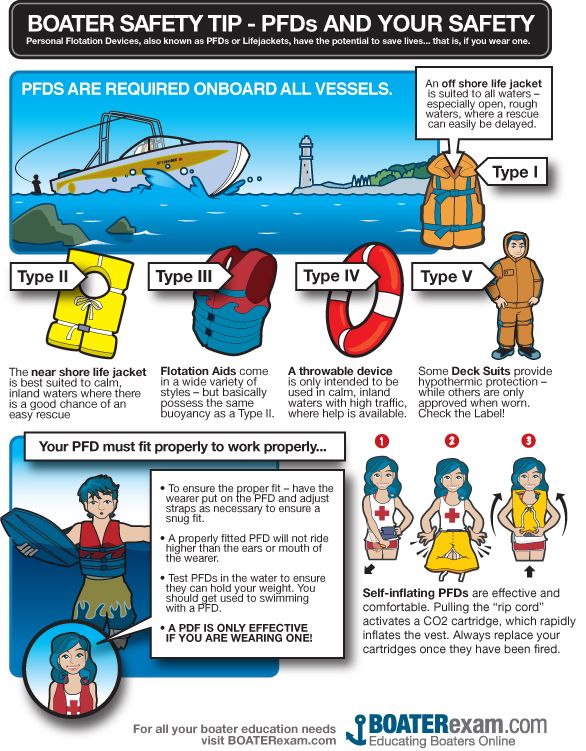Minimum Required Safety Equipment for Class 1 Recreational Vessels: 16 to less than 26 ft.
 Personal Flotation Devices (PFDs)
Personal Flotation Devices (PFDs)
One approved Type I, II or III for each person on board or being towed on water skis etc., in addition, one throwable Type IV device
Must be USCG-approved. Must be in serviceable condition. Must be properly stored.
NOTE: A Type V hybrid may substituted for any Type I, II or III device, but it must actually be worn whenever the vessel is underway and the person is not in the cabin or other enclosed area.
Class I: Every person on board under the age of 6 must wear an approved Type I, II or III while the vessel is underway.
Water Skier: Every person skiing or aquaplaning must wear an approved Type I, II or III PFD. Inflatable PFDs are prohibited.
Fire Extinguisher
One USCG-approved B-1 type fire extinguisher is required for all recreational motorboats except outboard-powered motorboats less than 26 feet long if constructed in a manner that will not allow gas fumes to accumulate. If your boat has a built-in fuel tank, an inboard engine, compartments where portable fuel tanks may be stored, or open areas between the hull and deck where flammable or explosive gases could accumulate, you must carry a fire extinguisher. Non-motorized boats are exempt from the fire extinguisher requirements.
The fire extinguisher must be USCG-approved and must be in serviceable condition.
NOTE: When an approved fixed fire extinguishing system is installed in the machinery space(s), it may be counted in the place of one B-I type hand-held portable fire extinguisher. Some fire extinguishers require specific mounting brackets for approval. Read the label on your fire extinguisher for this information.
Visual Distress Signal
Required on the high sea and coastal waters only.
Must carry visual distress signal for both day and nighttime use.
NOTE: Coastal waters means the Atlantic Ocean, Gulf of Mexico, and all bays, sounds, harbors, rivers, inlets, etc. where any entrance is over 2 miles wide to the first point where the distance between shorelines narrows to 2 miles.
Sound-producing Device (bell, horn, whistle, etc.)
Every vessel less than 12 meters (39.4 ft) in length must carry an efficient sound-producing device. The sound-producing device need not meet any particular specifications, as long as the vessel can produce signals required by the navigational rules.
Backfire Flame Control
An effective means of controlling backfire flame of all gasoline engines installed after April 25, 1940, except outboard motors
Backfire flame arrestors must be USCG approved.
Ventilation (Boats built prior to Aug. 1, 1980)
At least two ventilator ducts fitted with cowls or their equivalent for the purpose of properly and efficiently ventilating the bilges of every closed engine and fuel -tank compartment of boats constructed or decked over after April 25, 1940, using gasoline as fuel or other fuels having a flash point of 110 degrees or less.
Ventilation (Boats built after Aug. 1, 1980)
At least two ventilator ducts for the purpose of efficiently ventilating every closed compartment that contains a gasoline engine and every closed compartment containing a gasoline tank, except for those having permanently installed tanks which vent outside the boat and contain no unprotected electrical devices. Also, engine compartments containing a gasoline engine having a cranking motor must contain power operated exhaust blowers which can be controlled from the instrument panel.
Vessel Lighting
Recreational vessels are required to display navigation lights between sunset and sunrise and during periods of reduced visibility (fog, rain, haze, etc). The U.S. Coast Guard Navigation Rules specify lighting requirements for every description of watercraft. The information provided is for vessels less than 65.5 feet/20 meters in length.
Recommendations
We further suggest that you equip your vessel with an anchor and a sufficient amount of anchor line; a de-watering device, such as a bilge pump in the event of flooding; and an oar, paddle or other alternative means of propulsion in case your engine fails. If the above equipment requirements and suggestions are met, you may be eligible to display an FWC or Coast Guard Auxiliary safety decal. For more information, please contact your local FWC office.
For the most current information visit the myfwc website.
